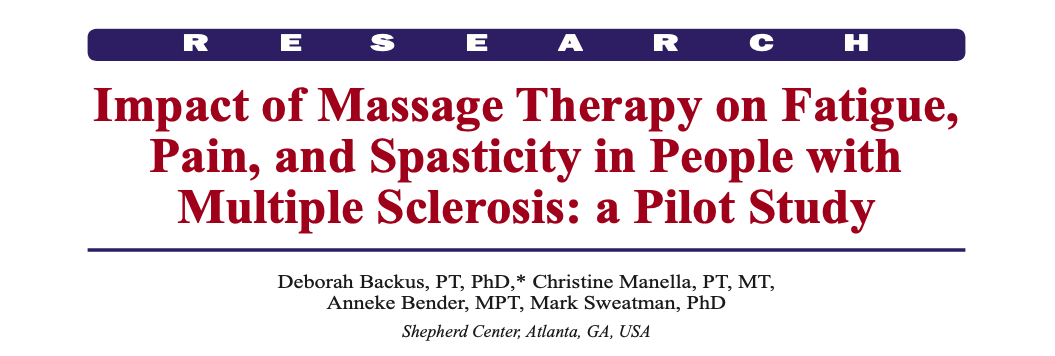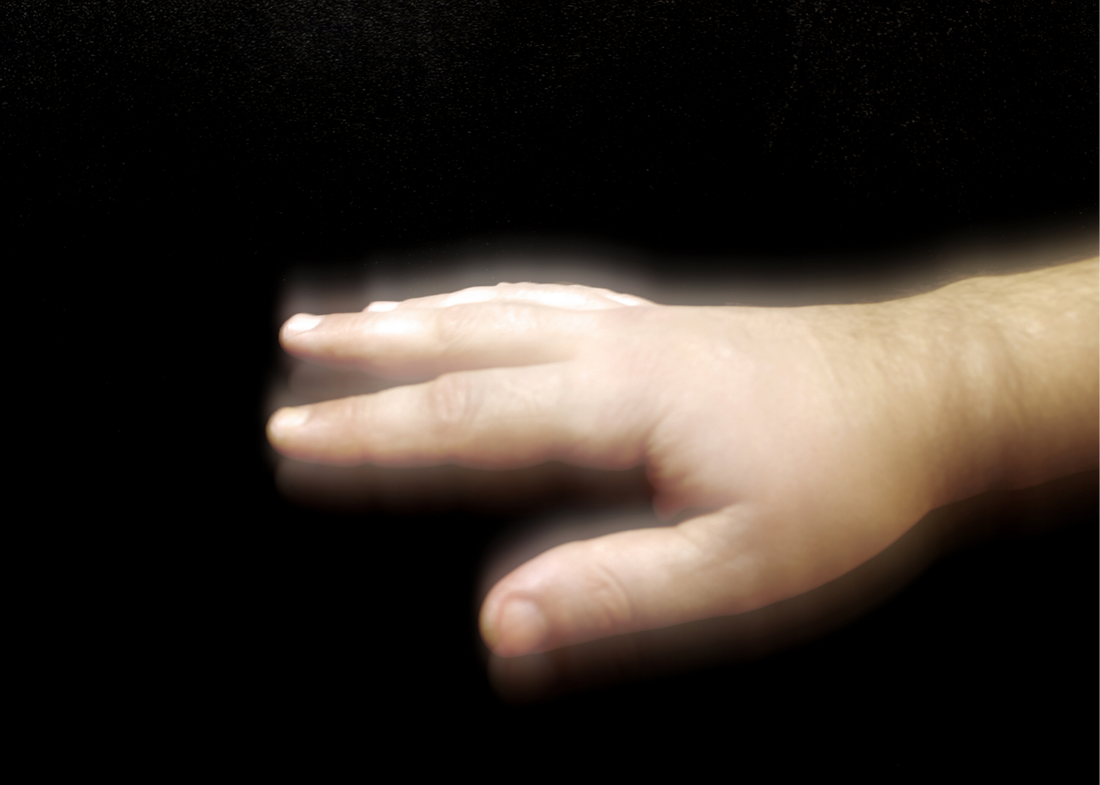|
Multiple Sclerosis is a many, many layered condition that has a long list of symptoms, including pain, fatigue, and weakness. There is currently no cure for MS. But just because there is no cure, does that mean there is nothing that can be done to help reduce these symptoms and maintain muscle health? From clinical experience, I've found massage and a variety of myotherapy techniques to be incredibly useful for patients living with MS. You can read more about my clinical experience with treating MS in this blog. I've been running for The May 50K during COVID19 isolation to raise funds and awareness for MS, so I thought its only fitting that I write up a bit of a literature review on the research! You can read the article here for the full study details, as published in the International Journal of Therapeutic Massage and Bodywork in December 2016. What does the research say specifically about massage therapy and MS?
There are a few things to keep in mind when we read this study. Firstly, manual therapies are hard to study, because the techniques used are almost always different every single treatment. As experienced therapists, we select techniques that are the most relevant to the patient each time they come for an appointment, and our selections are based off what we assess in the consultation, as well as what the patient agrees to on the day - for example, some days a deep pressure trigger point treatment can be tolerable and helpful, and other days it may feel too much. Secondly, Multiple Sclerosis affects people in widely different ways. There is no one "best" treatment technique for MS, and the symptom types, areas and intensity are vastly different from person to person. Keeping that in mind, lets have a look at how these researchers completed their study, and what they found. How did they design a study for massage therapy for Multiple Sclerosis? A specific massage sequence was designed for the study. This sequence was to be followed to the letter for every patient at every session, regardless of the symptoms on the day. This isn't an ideal way of providing a treatment in a clinical setting, however in a research setting its important to be able to make the tested treatment or therapy able to be reliably the same for every subject in the study. The sequence involved a full body massage therapy routine which included gliding strokes, kneading, cross fibre friction, and trigger point treatment. The 24 participants were scheduled for a weekly one hour treatment using the specific massage routine for 6 weeks. If a participant missed a scheduled treatment, they aimed to reschedule it within a week, so that each participant received 6 identical treatments over the course of no longer than 8 weeks. How did they measure and assess it? Five measurement scales were used to assess the outcomes in a variety of symptoms. The participants recorded scores for
What did they find out? The results overall suggested that massage therapy was a safe and useful tool in providing relief from fatigue and pain, and improving mental health and general quality of life. Fatigue - The MFIS indicated that 22 out of 24 participants reported decreased fatigue scores. There was a significant correlation between fatigue decreasing and pain decreasing. Spasticity - 19 out of 24 participants completed the MAS spasticity evaluation, and of these, 16 reported experiencing spasticity symptoms ranging from slight to considerable increase in muscle tone. There were no significant changes in spasticity after the end of the 6 week treatment period. Pain - On average, participants reported a significant 18% reduction in pain on the MOS Pain Effect Scale. The reduced pain scores correlated with improved mental health scores. Mental Health - A significant increase in the total scores on the MHI indicates overall mental health improvement. A small number of participants did not improve on some subscales, such as anxiety (3 participants) and depression (1 participant) Quality of Life - Overall, the quality of life scores on the HSQ showed improvement. Emotional and Social subscales showed more improvement than Health and Physical. The results indicated that as fatigue and pain decreased, measures of quality of life increased. Can we help you? Do you have MS and want to discuss treatment options? Our clinic is temporarily closed due to COVID19, but we expect to reopen by June. Check our availability on our online bookings page for updates. Are you receiving assistance from MS Employment Services? You may be eligible for funded Myotherapy treatment through your Occupational Therapist. Contact your OT to see if you can apply, and they will forward us the documents to begin the process for you. Do you have MS, you're currently working or seeking work, and you're not receiving assistance? Check the MS Employment Services website to see if you're able to receive support. We might not be able to see our MS patients face to face right now due to Covid19 restrictions, but thats not stopping us from helping in other ways!
We've created a team in The May 50K, which is a fundraising challenge to raise much needed funds for MS research. Our team is called Myotherapists for MS! The goal is to run 50km throughout May and raise donations and awareness to help support research for Multiple Sclerosis. What is Multiple Sclerosis or MS? Its a neuro-immune condition where the persons own immune system attacks their nervous system. It targets the myelin sheath, thats the insulating barrier between the nerve and its surroundings. Without myelin sheath, the nerve can't function in its usual way, and scarring (sclerosis) of the nervous system occurs. The normal nerve messages can get mixed up or lost, and it can cause a huge range of issues including:
Who are the Myotherapists for MS? Our team was created today by Mel and her good friend and mentor, Rhianna Bridgett. We're aiming to get a few more Myotherapists on board to help us stay motivated and to meet our goal of raising $1500 for MS. So far, the team includes:
Want to support us? Firstly, we all know and appreciate that these are hard times, the like of which most of us have never lived through before. So while donating is awesome, and we love and appreciate you if you are able to contribute a donation, its not the only way you can help our cause. What we would love to see more than anything is your support, inspiration and motivation! Basically - Keep us accountable! Make sure we complete our goals! Follow our journey on Facebook and boost our team morale by liking, loving, laughing at our posts, leave us a comment of encouragement, and share our achievements. Can you donate? If you can, we appreciate your support!! Want to know what your donation can achieve?
You'll also get a receipt automatically emailed out to you for tax time for any donation over $2 so you can claim the deduction. Go team!! Tremors are a common and frustrating symptom for people living with Multiple Sclerosis and other neurological conditions. They are involuntary muscle contractions which can cause shaking and unsteady movement. I recently spoke with a patient who had left her doctors appointment feeling very angry and insulted when her tremors were described as "Intention Tremors", because the message she was hearing was "you are intentionally causing these tremors". She immediately thought "no! Not another doctor telling me this is all in my head!" But Intention Tremor is the name of a type of neurological tremor, and although the name may sound like you have control here - or that it is your intention to cause the tremor - this is not the case. What is Intention Tremor?
Intention Tremors occur during movements that require coordination between your visual input and the movement of your affected limbs. For example, when you reach for a cup of coffee, firstly your eyes focus on the cup. Then your movement course to reach out your arm, open your hand and grasp the cup is plotted and coordinated by your cerebellum. It continually adjusts your course of movement by getting feedback from your eyes telling you how close you are to your coffee cup, and proprioception of your hand (that is, where you perceive your hand to be in relation to the rest of your body) With Intention Tremors, the nerves and brain areas that control the motions of moving your arm and hand are unable to produce smooth, fluid movements. Instead they get stuck in a jolting rhythm of muscle contractions. The involuntary contractions tend to become increased as you get closer to your goal - so the closer your hand gets to grabbing your cup, the more it shakes. When sitting still, the tremors can be minimal or completely stop. Have you spoken to your GP about your tremors? If you haven't spoken with your GP, please make a time to talk to them, especially if you're unsure if they are an indicator of a neurological condition. If you already have a diagnosis of a neurological condition, like MS or Parkinsons Disease, and if the tremors are a new symptom, its important to let you doctor know that you're experiencing this. Tremors don't always happen because of neurological diseases. They can occur due to stress, fatigue, vitamin deficiency, low blood sugar, or after an impact to your head like a fall, car accident or concussion, or after a brain injury like a stroke. You should always have a doctor investigate these symptoms. Can Myotherapy help Intention Tremors? We can't offer a cure for tremors. What we can help with is muscle pain, fatigue and tension that is often associated with tremors and neurological conditions. Myotherapy can be a great complementary therapy as part of a holistic treatment plan, but shouldn't be used as your only form of treatment. You can book an appointment time online or email us at [email protected] if you have questions before making a booking. |
Meet Our Team
We have a team of great practitioners available 7 days a week at our Rowville clinic. Archives
July 2024
Categories
All
|
Got a question about Myotherapy?
Contact Mel by phone, email or Facebook
|
Simple Wellness Myotherapy & Remedial Massage Clinic
Shop 12B 150 Kelletts Rd Rowville VIC 3178 |
Phone us on
03 8204 0970 |



 RSS Feed
RSS Feed